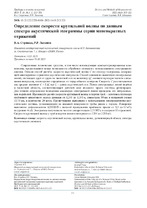Определение скорости крутильной волны по данным спектра акустической эхограммы серии многократных отражений

Date
2025Publisher
Another Title
Determination of the Velocity of a Torsional Wave Based on the Spectrum of an Acoustic Echogram of a Series of Multiple Reflections
Bibliographic entry
Стрижак, В. А. Определение скорости крутильной волны по данным спектра акустической эхограммы серии многократных отражений = Determination of the Velocity of a Torsional Wave Based on the Spectrum of an Acoustic Echogram of a Series of Multiple Reflections / В. А. Стрижак, Р. Р. Хасанов // Приборы и методы измерений. – 2025. – № 3. – С. 212-221.
Abstract
Современные технические средства, в том числе использующие компьютеризированные компоненты, предоставляют новые возможности обработки сигналов с использованием спектрального анализа. Описан способ расчёта скорости акустической волны С по спектру эхограммы, содержащей многократные отражения акустических импульсов. Способ основан на выявлении спектральных линий, отстоящих друг от друга по частотной оси на величину Δf , соответствующую частоте следования импульсов, многократно отражённых от торца объекта контроля. Скорость C рассчитывается как среднее значение C = LΔf, где L – длина акустической оси. Поиск спектральных линий ведётся в частотной области, соответствующей рабочей зоне входного тракта системы регистрации. Для точного определения положения максимума спектральной линии проведена его аппроксимация параболой. Произведён расчёт скорости крутильной волны в партии труб – заготовок плунжера глубинного штангового насоса длинами от 5,245 до 5,248 м, диаметром 59 мм и толщиной стенки 13,75 мм, в количестве 20 штук. Прозвучивание выполнено с использование электромагнитно-акустического датчика, установленного на внешней поверхности трубы рядом с торцом. Измерение выполнено дефектоскопом АДНШ-П с полосой пропускания приёмного тракта от 9,5 до 63 кГц по уровню -6 дБ. Эхограммы получены на частоте дискретизации 3,75 МГц и содержат 10 отражений. Скорости крутильной волны у труб в партии лежат в интервале от 3294 до 3298 м/с.
Abstract in another language
Modern technical means, including those using computerized components, provide new signal processing capabilities using spectral analysis. A method for calculating the velocity of an acoustic wave С from the spectrum of an echogram containing multiple reflections of acoustic pulses is described. The method is based on the detection of spectral lines spaced from each other along the frequency axis by Δf , corresponding to the pulse repetition rate repeatedly reflected from the testing object’s end. The velocity С is calculated as the average value С = LΔf, where L is the length of the acoustic axis. The search for spectral lines is carried out in the frequency domain corresponding to the working area of the input path of the registration system. To accurately determine the position of the maximum of the spectral line, it is approximated by a parabola. The velocity of the torsional wave was calculated in a batch of pipes – blanks of a plunger of a deep rod pump with lengths from 5.245 to 5.248 m, a diameter of 59 mm and a wall thickness of 13.75 mm, in the amount of 20 pieces. The sounding is performed using an electromagnetic acoustic sensor mounted on the outer surface of the pipe next to the end face. The measurement was performed with an ADNSH-P flaw detector with a receiving path bandwidth from 9.5 to 63 kHz at a level of -6 dB. The echograms were obtained at a sampling frequency of 3.75 MHz and contain 10 reflections. The torsional wave velocities of the pipes in the batch range from 3294 to 3298 m/s.
View/
Collections
- Т. 16, № 3[10]
